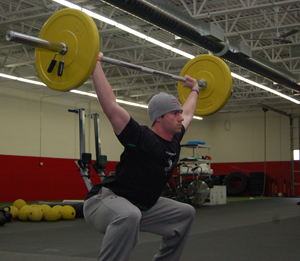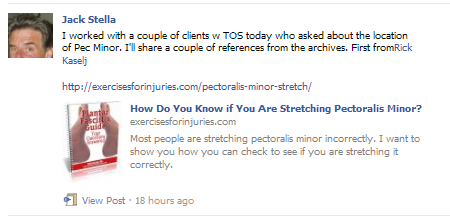![6_Ways_to_Improve_Thoracic_Mobility[1] 6_Ways_to_Improve_Thoracic_Mobility[1]](https://kcdn-dfbd.kxcdn.com/wp-content/uploads/2011/09/6_Ways_to_Improve_Thoracic_Mobility1.jpg)
Having a strong, mobile thoracic spine is one of the essential components for being able to lift heavy weights. If your upper back is stiff and immobile, you will be unable to lift as much weight as you’re capable of. Fortunately, there are a number of different ways that you can improve your thoracic mobility. Improving your thoracic mobility won’t just help you lift more weight at the gym, it will also assist you in everyday activities such as reaching items on high shelves or putting on a backpack that fits properly.
Before we get to the great info and exercises, I wanted to say thank you very much for commenting and Facebook liking my posts. It gives me great feedback on how I am doing, so please keep doing it.
Thank you very much to everyone who shares my articles with others. Like the foam roller exercise and pec minor stretch articles.
Now to today’s article, from Conor Nordegren:
Today’s general population is plagued by numerous upper extremity inefficiencies that contribute to less than optimal function. In this article, I’d like to focus on three common problem areas: the thoracic spine, serratus anterior, and lower trapezius.
Following the joint by joint approach, we know that the thoracic spine requires mobility, namely extension, and rotation. If there isn’t sufficient mobility in the thoracic spine, problems may arise along the kinetic chain. These problems include but are not limited to impaired function of the glenohumeral joint and compensations in the lumbar spine. As Mike Boyle stated in Advances in Functional Training, “The important thing about t-spine mobility is almost no one has enough, and it’s hard to get too much.” In other words, it is a good idea to include some dedicated thoracic mobility work in your comprehensive program, whether you lack mobility in that region or not.
Two muscles I’d like to address are the serratus anterior and lower trapezius. These muscles remain largely dormant in today’s population yet play an important role in shoulder function. As a society, we tend to suffer from dominance of the upper trapezius, the rhomboids, and levator scapulae, which Shirley Sahrmann calls “downward rotation syndrome.” Serratus anterior and lower trapezius are typically weak. Still, these muscles warrant attention as they serve to rotate the shoulder girdle upwardly and are vital to the proper functioning of the scapula and glenohumeral joint.
I want to show you some relatively simple drills that will help improve your thoracic mobility and activate and strengthen the serratus anterior and lower trapezius. I prefer to perform these drills as part of my warm-up or “filler” exercises throughout my training session. Several of these movements give you a good “bang for your buck” and address many common problem areas at once. Beyond just improving the function of the upper extremity, these drills will also have a favorable effect on your posture, which will lead to higher quality workouts and a higher quality of day-to-day life.
Bent-over Thoracic Spine Rotation
This drill focuses on rotation through the thoracic spine. Whenever I use it with clients, many remarks on how “good” it feels, beginning with your hands supinated and your hips back. Rotate through the chest as you raise one arm to the side with the thumb up, following your hand with your eyes. Be sure to keep your spine neutral throughout.
Quadruped Extension-rotation
As its name implies, the quadruped extension-rotation improves both thoracic extension and rotation. Begin with your hands underneath your shoulders and your knees underneath your hips. Keeping your spine in neutral, bring your elbow towards your opposite knee. Reverse the motion and come past the starting point while following your elbow with your eyes.
Forearm Wall Slides
Forearm wall slides work on activating serratus anterior and improving scapular rotation upward. Start with your elbows flexed 90 degrees, forearms parallel to the wall, and shoulder blades retracted. Slowly slide your forearms up the wall until you hit your end range and reverse the motion. Be sure to keep your head and neck neutral! Protract your shoulder blades, so your forearms are flat against the wall.
3-point Extension-rotation
This drill is a progression from the quadruped extension rotation. It accomplishes the same things but activates the serratus anterior and works on core and lumbar stability. Have your feet wide, make sure you rotate through the chest and brace that core to prevent lumbar hyperextension!
Scapular Wall Slides
The scapular wall slide improves activation and strength in the lower trapezius. Begin with your buttocks, upper back, and head in contact with a wall. Please keep your hands back, raise them overhead until you hit your end-range, then slide your arms down the wall, pull your shoulder blades down, and puff your chest out. Be sure to keep your chin tucked throughout.
No Money Drill
Not only does the no-money drill activate and strengthen the lower trapezius, but it also works on scapular stability and glenohumeral mobility. Start by retracting and depressing your shoulder blades while externally rotating your shoulder, moving your hands away from each other. Have your back against the corner of a wall or post, with a shoulder blade on each side of the corner. Again, there should be 3 points of contact with the wall or post: buttocks, upper back, and head. The elbows should be flexed to 90 degrees with your hands supinated. Don’t force the range of motion, and when you hit your end range, reverse the movement and return to the starting position. Keep your chin tucked!
These drills are simple yet effective and may be more complicated than they look! I hope you will add some of them to your program and see their value in improving upper body function. Good luck!
Conor Nordegren
Before I go, if you like the info above, get Muscle Imbalances Revealed – Upper Body Edition, where Tony Gentilcore, Dean Somerset, and Dr. Jeff Cubos will be sharing their tips, tricks, and exercises when it comes to upper body training. Including a lot more stuff on mobility and SMR.





